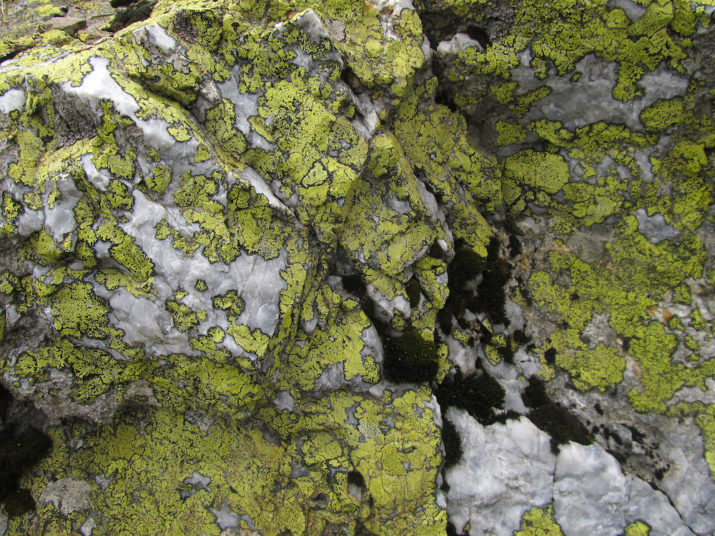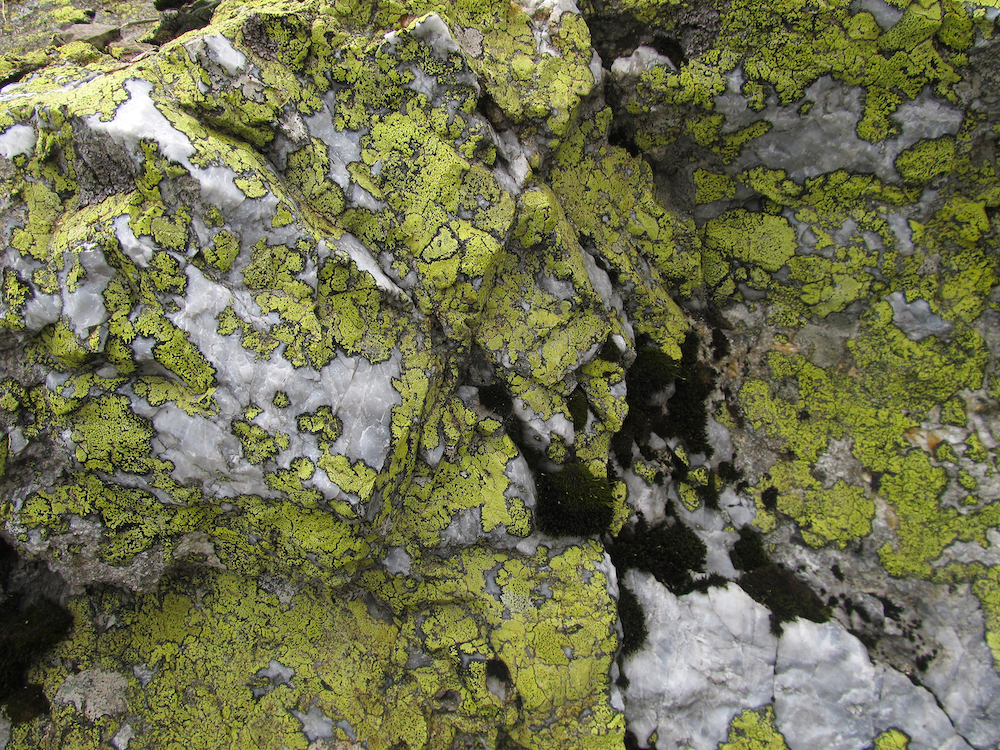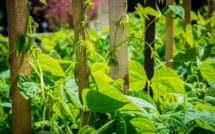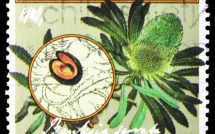

This is part of our special feature, Rethinking the Human in a Multispecies World.
The poetics of lichenness
In the small Indonesian city of Batu, I notice a squat human figure carved from the black volcanic stone typical of the island of Java. Its plump fingers rest on a trunk-like knee. Thick lips purse upward, revealing jagged teeth. Vacant, bulbous eyes stare coldly through me. On its forehead is a carving of a skull. Around its neck is a garland of miniature craniums. Known in Javanese mythology as Batara Kala, this fearsome god created light and embodies kāla, the Hindu concept of time. Something more than the statue’s sinister anatomical features, however, invites me to look closer. A pale-green patina encrusts the torso of the underworld deity. Although its right cheek is bare and as yet uncolonized, Batara Kala is being overtaken by lichen—one of the planet’s oldest, slowest-growing, and most neglected life forms.
A lichen is a mutualistic alliance, a microorganismic system, a symbiotic partnership, and a threshold organism. Creatures resembling lichens were among the first to arise from the primordial stew to colonize the planet. This ancient composite form of micromatter emerges from the interchange between a fungal partner (the mycobiont) and green algal or cyanobacterial cells (the photobiont). Whereas the photobiont produces sugars through photosynthesis, the mycobiont produces a suite of beneficial chemical compounds called secondary metabolites. Recent studies, moreover, have identified additional symbiotic partners such as basidiomycete yeasts and specialized bacteria. Evolutionary biologists Lynn Margulis and Eva Barreno describe lichens admiringly as mutualistic assemblages exemplifying “the details of complex individuality.”[1] Lichens, as I understand them, embody French philosopher Jean-Luc Nancy’s idea of “being singular plural.” The non-dualistic lichen mode of being—or what I call lichenness—embraces the inclusive potentiality of both/and rather than the oppositionality of either/or.[2]
I approach lichens here through a brief meditation on their cultural resonances, especially as depicted in poetry. After examining lichens at the micro-scale, or what lichenologists call “the lichen lifestyle,”[3] I reflect on some key moments in the historical marginalization of lichens before underscoring the importance of lichenness today in an ecologically degraded world. Toward these purposes, three contemporary poems provide lenses for reading lichens. Jane Hirshfield’s “For the Lobaria, Usnea, Witches Hair, Map Lichen, Beard Lichen, Ground Lichen, Shield Lichen” considers the lichen lifestyle as a “marriage of fungi and algae” yet questions the broader cultural disregard of lichens.[4] Through Hirshfield’s poem, “those nameless ones” reclaim their standing.[5] Adopting the perspective of the lichen itself, Arthur Sze’s “Lichen Song” similarly confronts the neglect of these ubiquitous and inimitable organisms with which people share their everyday domestic worlds.[6] Like the poems by Hirshfield and Sze, Forrest Gander’s “Twice Alive” gives prominence to the more-than-human wisdom of lichenness as a source of inspiration for learning to live more symbiotically on—and with—the Earth.
The lichen lifestyle: relations at the micro-scale
As research shows, some lichen species inscribe time’s inexorable advance. In the Arctic, seven-thousand miles north-east of my Javanese encounter with Batura Kala, communities of map lichen (Rhizocarpon geographicum) are estimated to be as old as nine-thousand years. When those stone-hugging lichen emerged as propagules during the Paleolithic Age, the world’s ten million hunting-gathering humans lived in small clans scattered widely across the Earth. Appearing as a crust on and, occasionally, within rock formations, R. geographicum is the most ubiquitous Arctic lichen. Easily mistaken by the untrained eye for an inert mineral layer on lithic surfaces, each lichen on close inspection reveals a complex topography of dull gold flecks of thalli (undifferentiated vegetative tissue) on charcoal-dark patches of fungal hypothalli (mats of hyphae). Biologists postulate that, in Greenland, for instance, map lichens grow at the exceedingly sluggish rate of one centimeter every one-hundred years. Yet, even so, other lichen species are known to increase their biomass by forty percent annually.
Although categorized taxonomically as fungi, lichens are more precisely symbiotic alliances encompassing two or three biological kingdoms. Lichenologists estimate that there are between 13,500 and 30,000 species worldwide. Approximately six percent of the Earth’s surface is cloaked in these composite creatures, described variously as “self-contained miniature ecosystems,”[7] “symbiotic amalgams,”[8] and symbiotic phenotypes of lichen-forming fungi.[9]Uncannily able to withstand inhospitable and, ordinarily, lethal conditions—and hence often given the label extremophiles—lichens inhabit almost all terrestrial ecosystems, from polar, subpolar, and alpine to forest, tropical, and coastal habitats. As epiliths, they populate bare rock surfaces; as endoliths, they embed themselves within the upper few millimeters of rocks. As dendrophiles, they affix their filigreed bodies to trees. Experiments have even shown that some lichens are impervious to outer space extremes. In one study, map lichens and other robust species were exposed to outer space for ten days before being returned to the Earth where they revealed minimal damage from radiation, temperature, and pressure. Researchers attribute the astonishing resilience of the space-going lichens, in part, to their exceptionally adaptive evolutionary constitution.[10]
The lichen lifestyle is marked by elements of process, change, adaptation, metamorphosis, and relationality. In Hirshfield’s words, these polyphonous organisms are “chemists of air, / changers of nitrogen-unusable into nitrogen-usable.”[11] Despite their apparent sessility—their fixedness in a place, except for occasional extraterrestrial liaisons—lichens reveal a tenacious drive to transform the material and immaterial, reconfigure bodies and minds, and disrupt strict boundaries between subjectivities (again, Nancy’s concept of “being singular plural” resonates here). By excreting various mineral-dissolving organic acids, for instance, lichens accelerate the chemical weathering of their stone—and statue—substrates.
It is no coincidence, then, that biologists have had to create a specialized lexicon to describe the unique generative capacities of lichens—a lexicon that also filters into the poetry of lichens. As a case in point, the term lichenizationdenotes the formation of a lichen after the successful recruitment of a fungal partner. The resultant lichen symbiosis yields a stable multispecies assemblage bearing deep evolutionary memory. To denote this process, some mycologists prefer the term lichenized fungi rather than lichen. Ancient in provenance, regardless of their designation, lichens such as R. geographicum observe a temporal cadence radically divergent from ours. In particular, the slow growth, old age, and broad distribution of crustose lichens make them integral to the science of geochronologic dating or what is known as lichenometry. This kind of research uses lichen growth rates as reference points for inferring the age of glacial landforms.
As Hirshfield’s “For the Lobaria” reminds us, lichens display a stunning multiplicity of growth habits. These include fruticose (shrub-like), foliose (leaf-like), filamentous (hair-like), leprose (powdery), squamulose (scaly), gelatinous (water-absorbing), and crustose (crusty) forms. The coloration of lichens varies from orange, yellow, and red to green, gray, and black. They can be as small as two-centimeter splotches, as in powder-back lichen (Physcia caesia), or as large as two-meter tassels dangling from tree branches, as in old man’s beard (Usnea spp.). Sprawling, ramifying, and propagative—much like lichens themselves—Hirshfield’s poem evokes the sheer heterogeneity of lichen forms. Its title enumerates seven visually descriptive vernacular names, including map, beard, ground, and shield lichens. This lyrical reveling in unrestrained lichenness continues with the final stanza’s recitation of six more names, “Rock wools, water fans, earth scale, mouse ears, dust, / ash-of-the-woods.”[12] The tone is reverent verging on incantatory. In the light of her increasing attentiveness to lichens in the urban environment, the narrator laments, “Back then, what did I know? / The names of subway lines, busses.”[13]
Lichens are boundary-crossing, relation-seeking, category-eliding, and world-forming. In “For the Lobaria,” they are also poietic in the ancient Greek sense of “to make” yet they remain unappreciated and neglected culturally. These beings-singular-plural are the marginalized changers, shapers, and engravers of the world. Addressed in the second-person—as a “you”—
the poem’s lichen-subject is invariably an enigma:
When I saw you, later, seaweed reefed in the air,
you were grey-green, incomprehensible, old.
What you clung to, hung from: old.
Trees looking half-dead, stones.[14]
Defying facile categorization, the lichen is analogized to a seaweed. The final two lines, however, signify a revaluation of lichens as types of life forms that matter: “Transformers unvalued, uncounted. / Cell by cell, word by word, making a world they could live in.”[15] The theme of a heightened awareness of micromatter in response to encounters with lichens in everyday life continues in Sze’s “Lichen Song,” the second lichenized poem to feature here.
Lichen as transmigrant? genealogies of indifference
Gracefully inhabiting the threshold between life forms, lichens are plant-like—and, for that matter, seaweed-like—but neither true plants nor genuine seaweeds. Although they have received sporadic scientific treatment since the nineteenth century, lichens have for the most part been sidelined by biologists, institutions, and the public at large for various reasons. The lichenologist, it seems, is an even rarer breed than the mycologist in the United States and elsewhere. In 2016, as a case in point, biodiverse Southern California had only one professional lichenologist, Kerry Knudsen, the founder of the Lichen Herbarium at UC Riverside and identifier of more than sixty new species.[16] As of 2020, though, Knudsen appears to be lichenizing professionally in the Czech Republic. Thus, the lichenologist may be as neglected a subject as the lichen of his or her yearning.
Sze’s “Lichen Song” opens with the admonition, “you’ve seen a crust on the ceiling wood and never considered how I gather moisture when you step out of the shower.”[17] His prose poem concludes with the intimation that human-lichen estrangement has a perceptual basis: “you cough only look yes look at me now because you are blink about to leave.”[18]The lichen-indifference syndrome to which Sze alludes can partly be attributed to a failure of perception. Lichens typically present as nondescript crusts or masses on rock and tree surfaces. Their physical mutability renders them elusive to the mind’s classificatory impulse. They enjoy a malleable ontological status in a strange liminal zone between plants, fungi, algae, bacteria, and the so-called inanimate domain of boulders, bark, and soil. Their temporality—in conjunction with their evolutionary memory—defies the limited human purview sanctioned by history and culture. Simply put, humankind is uncertain how to approach, engage with, and care for the lichen world without the specialized armature of natural science. Meanwhile, those pale-green patinas continue to infiltrate subways, statues, and showers.
Historically, lichens appear intermittently in the writings of Dioscorides, Pliny the Elder, and Theophrastus. Theophrastus devised the term lichen from the Greek verb “to suck” in order to denote the uncanny ability of the compound creatures to absorb water. In the nineteenth century, biologists lumped lichens in with plants because of their power to photosynthesize. During the 1860s, however, Swiss botanist Simon Schwendener departed from the era’s conventional thinking by characterizing lichens as organismic conglomerations that thrive on parasitical power dynamics. In rather affected terms, he speculated that the “master is a fungus […] a parasite, accustomed to live upon the work of others, its slaves are green Algae, which it has gathered around itself, at any rate, holds on to and forces into service.”[19] The subjugated algae dejectedly were “forever imprisoned to prepare nutriment for themselves and their master.”[20]
In contrast, by the 1870s, French botanist Jean-Baptiste Edouard Bornet surmised that the mycobiont-photobiont association is essentially symbiotic rather than parasitic. What’s more, in a scientific paper appearing early in her career, naturalist and children’s author Beatrix Potter—herself acquainted with the research of Schwendener and Bornet—concurred that lichens are mutualistic, multispecies complexes. The early-to-mid-twentieth century, though, saw an increased conflation of lichens with seaweeds. In an essay curiously title “The Lichen as Transmigrant,” chemist A. H. Church imaginatively propounded that seaweeds transformed into primitive fungi after being stranded on land and invaded by unicellular algae.[21] Later, in the 1960s, botanist E. J. H. Corner wrote of lichens as terrestrial seaweeds.[22]As beings-singular-plural, lichens have perplexed observers from Dioscorides to the present day. And, despite our best efforts, will we ever really know what a lichen is?
Sze’s writing personalizes the broader Western disaffection between humans and lichens. The poem’s splotchy, organic arrangement visually evokes the archetypal lichen form. Presented from the lichen’s point of view—and lichen-like in appearance—the textual narrative supplies a medium for the disenchanted voice of these more-than-humans: “you don’t care that I respire as you breathe” and “you don’t understand how I can dive to a temperature of liquefied gas,”[23] the latter statement alluding to the outer space experiment mentioned in the previous section. Whereas the speaker is preoccupied with efficiently performing mundane activities (showering, shaving, combing his hair), the lichen boldly maintains its own temporal disposition: “I who may grow an inch in a thousand years catch the tingling sunlight.”[24] In this way, the poem construes lichenness as the deep capacity for symbiotic relation, mutual understanding, and interspecies empathy: “if you absorb not blot my song you could learn you are not alone in pain and grief.”[25]
A contested mutuality: lichen mattering
The idea of lichenness put forth here calls attention to the conglomerative, pluralistic nature of lichens. In its radically-open otherness, lichens materialize more-than-human wisdom—the knowledge of the world expressed by intelligent beings other than humans. As naturalist Trevor Goward quips, “lichens are fungi that have taken up agriculture. Fungi, like animals (but unlike most plants), are unable to manufacture their own carbohydrates; to survive, they must extract sugars from other organisms.”[26] Lichenness may enable humankind to envision sustainable, cooperative approaches to addressing the critical issues of the Anthropocene—the present geological age marked by widespread human-induced alterations of the biosphere. Lichenness directs us toward greater harmonization with the Earth, coaxing us away from historically-entrenched divisions between life forms. Inspiring us to dwell in the awareness that being alive is always a matter of being singular plural, lichen lessons merit listening.
As the third lichenized poem figuring into this meditation, Forrest Gander’s “Twice Alive” (an inversion of the trope of lichen as “half alive”) celebrates communities of more-than-humans.[27] Excerpted from Gander’s extended poetic meditation on lichens, the narrative intertwines the language of lichenology—the technical terms mycobiont and photobiont govern the opening two lines—with the colloquial names umbilicate, rock tripe, sunburst, and wolf. In the poem, lichenness is a mode of becoming in which each individual agent—fungal, algal, bacterial—evolves synergistically into “something else its own life and a / contested mutuality twice alive.”[28] “Twice Alive” can also be understood as a sensory evocation of the dynamic multispecies imbrications between lichens, mites, mushrooms, moss, and people: “I crush oak moss between finger and thumb / for its sweet perfume persistent on / your skin.”[29]
Central to these writings by Gander, Sze and Hirshfield, the neglect of lichens is symptomatic more broadly of human estrangement from the natural environment in hypercapitalist societies. Nonetheless, lichens still provide significant sources of food, fiber, fuel, dye, medicine, poison, cosmetics, and perfumes in many Indigenous cultures globally. The specialized field of ethnolichenology investigates the interactions between people and lichens. Among the “lichenophilic communities” of Nepal, for example, lichens are used for a range of medicinal, ritual, spiritual, culinary, aesthetic, decorative, and ethno-veterinary purposes.[30] What’s more, the Mönpa people of Arunachal Pradesh, India, prepare reindeer lichen (Cladonia rangiferina) as a remedy for kidney stones whereas the Alaskan Denaʼina consume the same species crushed, boiled, and compounded with berries or lard.
Lichens collectively represent the intimate connection between the health of people and non-people. Recent clinical trials suggest that extracts of reindeer lichen degrade prions, the misshapen proteins associated with neurodegenerative diseases. Other studies link a decline in lichen diversity to increased lung cancer rates. Yet, not only mattering to human wellbeing, lichens are ideal biomonitors of ecosystemic fitness. Without protective tissues, lichens absorb water, gasses, and chemicals directly from the atmosphere. The concentrations of toxins in lichen thalli, for instance, correlate directly to environmental levels. As air pollution and climate disturbance increase, lichen communities decline proportionally—and vice versa. Lichens are also efficient bioindicators of plant wellbeing. Ecosystems with greater botanical diversity tend to host more widely varied lichen communities.
In their deep-time evolutionary wisdom, lichens disrupt the categorical binaries that structure Western thinking. Gander’s poem thus ends with the assertion, “it is rarely possible to tell / if lichen is dead or alive.”[31] His assertion about lichenness—that is, the particular nature of lichen-being—recollects Hirshfield’s association of lichens with stones and half-dead trees. Becoming lichen-minded requires accepting the possibility of death-within/as-life. The phrase “it is rarelypossible,” furthermore, connotes that attuning to lichenness results from sustained, careful attending over time. Just as we learn that Sze’s “crust on the ceiling wood” actually “respires as you breathe,” lichen lessons gently shock us out of the stupor of supermodernity.
Becoming lichen-minded
Like fungi, thoughts, and poems, the statue of Batara Kala in Batu, Indonesia, is becoming lichenized. Over time, the stout legs of the Javanese god will be rendered pale, encrusted, and weathered. The globular eyes will turn into hollow pits. The cheeks will wrinkle and sink. In my meditation on lichenness here, I have attempted to show that cultural objects, such as statues and poems, offer vital media for contemplating lichenness and becoming lichen-minded. Lichen micromatter is valuable because it leads us beyond the perils of individuality toward a view of life as relational and ramifying. A transformation of consciousness—precipitating a revitalized politics—through the influence of lichenness is an urgent task on a planet ever more devitalized by the loss of life and the withering of wonder.
John Charles Ryan is Adjunct Associate Professor at Southern Cross University, Australia, and Adjunct Senior Research Fellow at the Nulungu Institute, Notre Dame University, Australia. His research focuses on Aboriginal Australian literature, Southeast Asian ecocriticism, environmental humanities, ecopoetics, and critical plant studies. His recent work includes Introduction to the Environmental Humanities (2021, authored with J. Andrew Hubbell), The Mind of Plants: Narratives of Vegetal Intelligence (2021, edited with Monica Gagliano and Patrícia Vieira), and Nationalism in India: Texts and Contexts (2021, edited with Debajyoti Biswas).
References
[1] Lynn Margulis and Eva Barreno, “Looking at Lichens,” BioScience 53, no. 8 (2003): 778.
[2] Jean-Luc Nancy, Being Singular Plural (Stanford, CA: Stanford University Press, 2000).
[3] David L. Hawksworth, “Lichenization: The Origins of a Fungal Life-Style,” in Recent Advances in Lichenology: Modern Methods and Approaches in Lichen Systematics and Culture Techniques, eds. D. K. Upreti, P. K. Divakar, V. Shukla, and R. Bajpai (Delhi: Springer India, 2015), 1–10.
[4] Jane Hirshfield, For the Lobaria, Usnea, Witches Hair, Map Lichen, Beard Lichen, Ground Lichen, Shield Lichen(Berkeley, CA: Tangram Press, 2011), l. 10.
[5] Hirshfield, For the Lobaria, l. 13.
[6] Arthur Sze, “Lichen Song,” Narrative (2016), accessed July 21, 2020, https://www.narrativemagazine.com/authors/arthur-sze.
[7] Thomas H. Nash, “Introduction,” in Lichen Biology, ed. Thomas H. Nash (Cambridge, UK: Cambridge University Press, 2008), 1–8.
[8] Rachel Sussman, The Oldest Living Things in the World (Chicago: University of Chicago Press, 2014), 70.
[9] Rosmarie Honegger, “The Symbiotic Phenotype of Lichen-forming Ascomycetes and Their Endo- and Epibionts,” in The Mycota: Fungal Associations, vol. 9, ed. Bertold Hock (Berlin: Springer Nature, 2012), 287–339.
[10] Rosa de la Torre, et al., “Survival of Lichens and Bacteria Exposed to Outer Space Conditions – Results of the Lithopanspermia Experiments,” Icarus (2010): 735–748.
[11] Hirshfield, For the Lobaria, ll. 11–12.
[12] Ibid., ll. 17–18.
[13] Ibid., ll. 1–2.
[14] Ibid., ll. 6–9.
[15] Ibid., ll. 19–20.
[16] Daniel Gumbiner, “The Ex-Anarchist Construction Worker Who Became a World-Renowned Scientist,” The Atlantic May 19, 2016, accessed July 21, 2020, https://www.theatlantic.com/science/archive/2016/05/life-of-a-lichenologist/482157/.
[17] Sze, “Lichen Song.”
[18] Ibid.
[19] Simon Schwendener, Die Algentypen der Flechtengonidien (Basel, Switzerland: University of Basel, 1869).
[20] Ibid.
[21] Arthur Herbert Church, “The Lichen as Transmigrant,” American Journal of Botany 59 (1921): 40–46.
[22] Edred John Henry Corner, The Life of Plants (London: Weidenfeld & Nicolson, 1964).
[23] Sze, “Lichen Song.”
[24] Ibid.
[25] Ibid.
[26] Trevor Goward, “Living Antiquities,” Nature Canada 23, no. 3 (1994): 15.
[27] Forrest Gander, “Twice Alive (Excerpt),” Manoa 31, no. 1 (2019): 32.
[28] Gander, “Twice Alive,” ll. 3–4.
[29] Ibid., ll. 11–13.
[30] Shiva Devkota, et al., “Indigenous Knowledge and Use of Lichens by the Lichenophilic Communities of the Nepal Himalaya,” Journal of Ethnobiology and Ethnomedicine 13, no. 15 (2017): 2–10.
[31] Gander, “Twice Alive,” ll. 19–20.
Photo: Rhizocarpon geographicum on quartz. Yellow lichen covering a rock in the mountains | Shutterstock
Published on November 9, 2021




